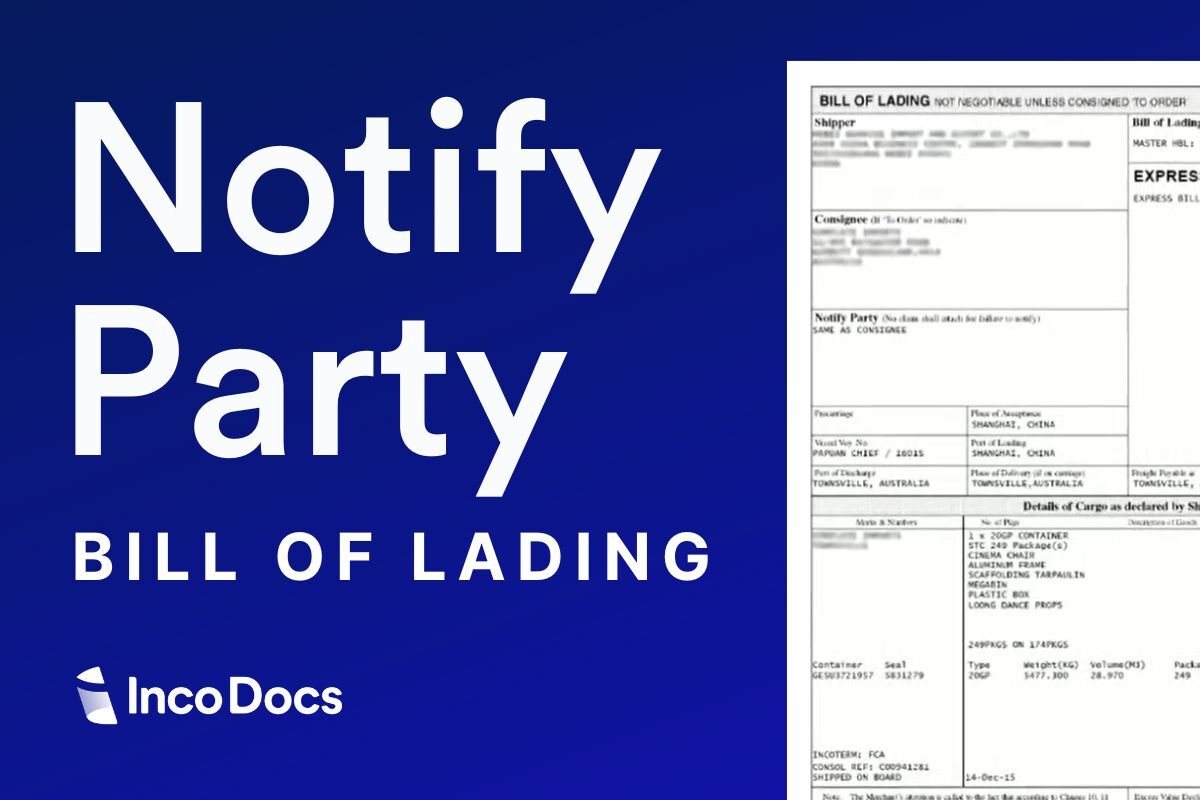
Artikel
02
mei
Notify Party in Shipping: Exploring Differences in Bill of Lading Documentation
What is a Bill of Lading Document?
In international shipping, the Bill of Lading document makes up a critical part of the shipment process, which includes details of the Shipper, Consignee and Notify Party. They are legal documents that provide evidence or proof of shipment. This is critical in the import export process as they provide title as to which party legally owns the cargo.
The Bill of Lading (BOL) acts as evidence of contract of carriage, receipt of goods and document of title to the goods. In some cases the BLs are negotiable which means that they can be transferred to another party. The holder of the original BL has the legal rights to claim the goods or arrange transfer of ownership of the cargo to another party.
In this article we’ll look at the roles of a Notify Party and Consignee on a Bill of Lading document.
What is a Notify Party on a Bill of Lading?
The Notify Party is the entity that should be contacted about the arrival of the cargo. This party can be either an individual or a company and is typically involved in some aspect of the cargo’s handling, release, or ultimate delivery upon its arrival at the destination port.
It’s important to note that the notify party is not necessarily responsible for taking possession of the cargo. Their role is more about being informed of the cargo’s arrival so that they can take necessary actions such as arranging for customs clearance or notifying the consignee.
What is a Consignee on a Bill of Lading?
The consignee is named on the B/L as the recipient and is recognized as the cargo’s legal owner upon its arrival, who will claim the cargo and fulfil all related obligations such as paying applicable import duties & taxes.
The consignee will ensure compliance with the destination’s import regulations, playing a key role in the customs clearance process and final delivery of the cargo.

What is the difference between the Consignee and Notify Party?
The consignee is the official recipient of the shipment, often the shipment’s owner, to claim the cargo at the destination. They will handle legal and regulatory requirements during the customs clearance process, including payment of applicable import duties and taxes.
The notify party is only informed of the arrival of cargo arrival, but does not own the cargo. The key difference between a consignee and a notify party on a bill of lading revolves around their roles and responsibilities:
Consignee: This is the individual or entity that is legally entitled to receive the cargo. In other words, the consignee is the owner of the goods upon their arrival at the destination. They have the authority to claim the shipment from the carrier, and the cargo is released to them after all customs and import requirements are satisfied.
Notify Party: As mentioned, the notify party is the individual or company to be informed when the cargo arrives at its destination. Their primary role is informational. They might be tasked with coordinating further logistics such as inland transportation or customs clearance but do not have the same legal claim to the cargo that the consignee does. Often, the notify party and the consignee can be the same entity, especially in smaller operations or more straightforward shipping arrangements.
Does a Bill of Lading have to include a notify party?
Including a notify party on a bill of lading is not a mandatory requirement for the document to be considered valid. However, it is a common practice in international shipping due to its practical benefits. Having a designated notify party helps ensure smooth communication and coordination for the receipt of the shipment, aiding in the logistics process significantly, especially in complex supply chains.
If a notify party is not specified, the carrier will communicate directly with the consignee regarding the arrival of the cargo, which can sometimes lead to delays if the consignee is not prepared or available to act immediately upon the cargo’s arrival.
Additional Resources
What's your reaction ?
Follow us on Social Media
Recent posts

May 15, 2024
Special report: Pension funds grapple with the just transition

May 15, 2024
New climate adaptation and resilience framework launched for investors

May 15, 2024
M&G injects over €100m into blended finance fund supporting economic growth in Southeastern Europe

May 15, 2024
Fashion-focused carbon emissions software firm raises $15m

May 15, 2024
Blended finance deals reach $15bn five-year high

 Inloggen
Inloggen
 Registreren
Registreren






Comments (0)
No reviews found
Add Comment